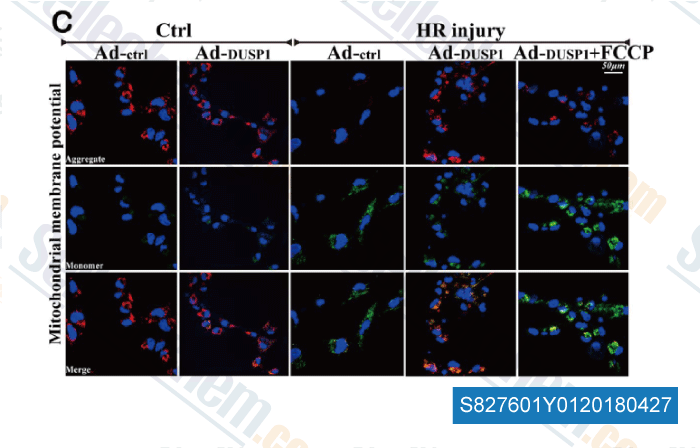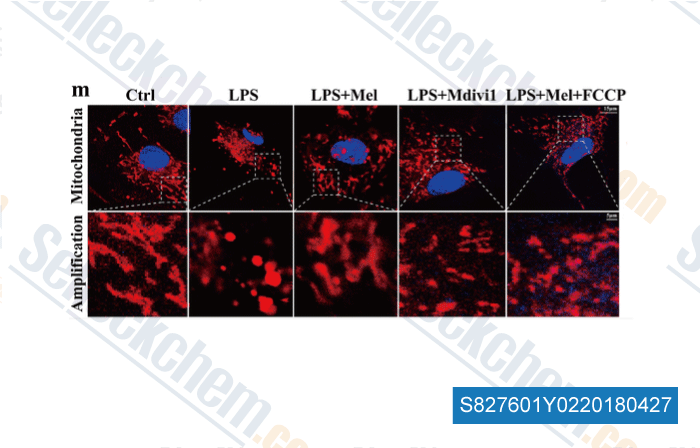|
Toll Free: (877) 796-6397 -- USA and Canada only -- |
Fax: +1-832-582-8590 Orders: +1-832-582-8158 |
Tech Support: +1-832-582-8158 Ext:3 Please provide your Order Number in the email. |
Technical Data
| Formula | C10H5F3N4O |
|||
| Molecular Weight | 254.17 | CAS No. | 370-86-5 | |
| Solubility (25°C)* | In vitro | DMSO | 51 mg/mL (200.65 mM) | |
| Ethanol | 51 mg/mL (200.65 mM) | |||
| Water | Insoluble | |||
|
* <1 mg/ml means slightly soluble or insoluble. * Please note that Selleck tests the solubility of all compounds in-house, and the actual solubility may differ slightly from published values. This is normal and is due to slight batch-to-batch variations. * Room temperature shipping (Stability testing shows this product can be shipped without any cooling measures.) |
||||
Preparing Stock Solutions
Biological Activity
| Description | FCCP (Trifluoromethoxy carbonylcyanide phenylhydrazone, Carbonyl cyanide 4-(trifluoromethoxy)phenylhydrazone) is a potent uncoupler of oxidative phosphorylation in mitochondria that disrupts ATP synthesis by transporting protons across cell membranes. | ||
|---|---|---|---|
| Targets |
|
||
| In vitro | FCCP treatment induces a very rapid 2-fold increase in intracellular Ca2+ concentration that is accompanied by a strong protein synthesis rate inhibition. The translation inhibition correlates with an increased phosphorylation of the α subunit of eIF2 (eIF2α) and a 1.7-fold increase in the double-stranded RNA-dependent protein kinase activity[1]. FCCP treatment also mildly decreases ATP and reactive oxygen species levels. It increases the expression of mitochondrial genes such as Tfam and COXIV while inducing morphological features of quiescent mouse HSCs and abrogating TGF-β signal transduction[2]. |
||
| In vivo | FCCP significantly reduces mitochondrial membrane potential and ATP production in 8-cell mouse embryos and the number of inner cell mass cells within blastocysts with unchanged blastocyst development. This perturbed embryonic mitochondrial function is concomitant with reduced birth weight in female offspring following embryo transfer, which persists until weaning. Although FCCP-treated males also exhibits reduced glucose tolerance as female, but their insulin sensitivity and adiposity gain between 4 and 14 weeks is unchanged. Reducing mitochondrial function and, thus, decreasing ATP output in the precompacting embryo can influence offspring phenotype[3]. |
Protocol (from reference)
| Cell Assay: |
|
|---|---|
| Animal Study: |
|
References
Customer Product Validation

-
Data from [Data independently produced by , , J Pineal Res, 2018, 64:e12450]

-
Data from [Data independently produced by , , Redox Biology, 2018, 14:576-587]

-
Data from [Data independently produced by , , Redox Biology, 2018, 14:59-71]

-
Data from [Data independently produced by , , Cell Stress and Chaperones, 2018, 23(2):281-293]
Selleck's FCCP has been cited by 64 publications
| Immune evasion through mitochondrial transfer in the tumour microenvironment [ Nature, 2025, 10.1038/s41586-024-08395-9] | PubMed: 39843734 |
| Medium from human iPSC-derived primitive macrophages promotes adult cardiomyocyte proliferation and cardiac regeneration [ Nat Commun, 2025, 16(1):3012] | PubMed: 40148355 |
| Menin maintains lysosomal and mitochondrial homeostasis through epigenetic mechanisms in lung cancer [ Cell Death Dis, 2025, 16(1):163] | PubMed: 40057469 |
| MANF facilitates breast cancer cell survival under glucose-starvation conditions via PRKN-mediated mitophagy regulation [ Autophagy, 2024, 1-22.] | PubMed: 39147386 |
| The DNA-dependent protein kinase catalytic subunit exacerbates endotoxemia-induced myocardial microvascular injury by disrupting the MOTS-c/JNK pathway and inducing profilin-mediated lamellipodia degradation [ Theranostics, 2024, 14(4):1561-1582] | PubMed: 38389837 |
| Knockdown of hepatic mitochondrial calcium uniporter mitigates MASH and fibrosis in mice [ Cell Biosci, 2024, 14(1):135] | PubMed: 39523398 |
| Pseudouridine synthase 1 regulates erythropoiesis via transfer RNAs pseudouridylation and cytoplasmic translation [ iScience, 2024, 27(3):109265] | PubMed: 38450158 |
| A pharmacological toolkit for human microglia identifies Topoisomerase I inhibitors as immunomodulators for Alzheimer's disease [ bioRxiv, 2024, 2024.02.06.579103] | PubMed: 38370689 |
| HIGD1A links SIRT1 activity to adipose browning by inhibiting the ROS/DNA damage pathway [ Cell Rep, 2023, 42(7):112731] | PubMed: 37393616 |
| Targeting mitochondrial energetics reverses panobinostat- and marizomib-induced resistance in pediatric and adult high-grade gliomas [ Mol Oncol, 2023, 17(9):1821-1843] | PubMed: 37014128 |
RETURN POLICY
Selleck Chemical’s Unconditional Return Policy ensures a smooth online shopping experience for our customers. If you are in any way unsatisfied with your purchase, you may return any item(s) within 7 days of receiving it. In the event of product quality issues, either protocol related or product related problems, you may return any item(s) within 365 days from the original purchase date. Please follow the instructions below when returning products.
SHIPPING AND STORAGE
Selleck products are transported at room temperature. If you receive the product at room temperature, please rest assured, the Selleck Quality Inspection Department has conducted experiments to verify that the normal temperature placement of one month will not affect the biological activity of powder products. After collecting, please store the product according to the requirements described in the datasheet. Most Selleck products are stable under the recommended conditions.
NOT FOR HUMAN, VETERINARY DIAGNOSTIC OR THERAPEUTIC USE.
